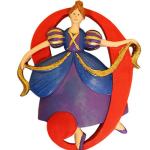 Day 9. Using STACK to write questions to assess maths. There may or may not be nine ladies dancing, but there is certainly one female blogger who would happily do a little dance around her house this evening. I’ve managed to prise another few hours this afternoon to write another STACK question and I am oh so happy with the result. I feel a bit embarrassed to be writing about STACK and, yes, it did take me several hours to write one question. I am a real beginner, standing on the shoulders of giants (Chris, Tim, Phil – that’s you). In writing STACK questions I am having to learn STACK, learn Maxima, learn Moodle, learn LaTeX, and – as I get onto questions that assess rather more maths than basic differentiation – I will be having to dig deep into my memory (and revise from the module materials which the questions are designed to support) from the days, something approaching 40 years ago, when I might have described myself as a mathematician. But I am loving every minute of it.
Day 9. Using STACK to write questions to assess maths. There may or may not be nine ladies dancing, but there is certainly one female blogger who would happily do a little dance around her house this evening. I’ve managed to prise another few hours this afternoon to write another STACK question and I am oh so happy with the result. I feel a bit embarrassed to be writing about STACK and, yes, it did take me several hours to write one question. I am a real beginner, standing on the shoulders of giants (Chris, Tim, Phil – that’s you). In writing STACK questions I am having to learn STACK, learn Maxima, learn Moodle, learn LaTeX, and – as I get onto questions that assess rather more maths than basic differentiation – I will be having to dig deep into my memory (and revise from the module materials which the questions are designed to support) from the days, something approaching 40 years ago, when I might have described myself as a mathematician. But I am loving every minute of it.
I’m loving it so much that I am going to bore you with the question I wrote this afternoon, and some of my feedback. It’s shown below.
Behind the scenes, the computer algebra system Maxima is checking that the answer I have typed is equivalent to the required first derivative. But if I were to try to ‘cheat’ by typing ‘diff’ and then the function it would tell me to get stuffed – politely of course. There is nothing to stop me typing the function to be differentiated into Maxima or another computer algebra system of course, but you can’t win them all!
The power of Maxima means that I no longer have to second guess all the equivelent correct answers that my students are going to give; nor the equivalent wrong answers for which I want to give targeted feedback. I have written the question so that different students see different variants – or, in formative use, students can obtain different variants for practice. And, when I have finished writing this post, I’m hoping that it will be easy to make a minor modification to the question so that it looks quite different. It might even be better. It might even really need the Quotient Rule. I did say I was a beginner…
Now I’ve shown you one of the five questions I have written so far, I just have to show you another one.
In this case, algebraically equivalent expressions are not accepted as correct, for obvious reasons. Choices about this sort of thing are entirely in my hands, as the question author and Chris Sangwin (the originator of STACK) seems to have thought of everything. Did I say, I think this is rather good…
I’ve tried to work out just why it is that using STACK makes me so happy. It’s partly because it is so good, but it is also because I am back to writing questions rather than theorising – and I’m learning, increasing my skill set, feeling that I am moving forward. I also feel closer to our students; I am helping to produce a resource that I know will help them. I’m beginning to think about their misunderstandings (and, once students have tried the questions, I’ll be looking at their answers, working out what mistakes they have made, providing better feedback and thinking about how we could improve our teaching). Basically, I’m a teacher and I’m teaching!


